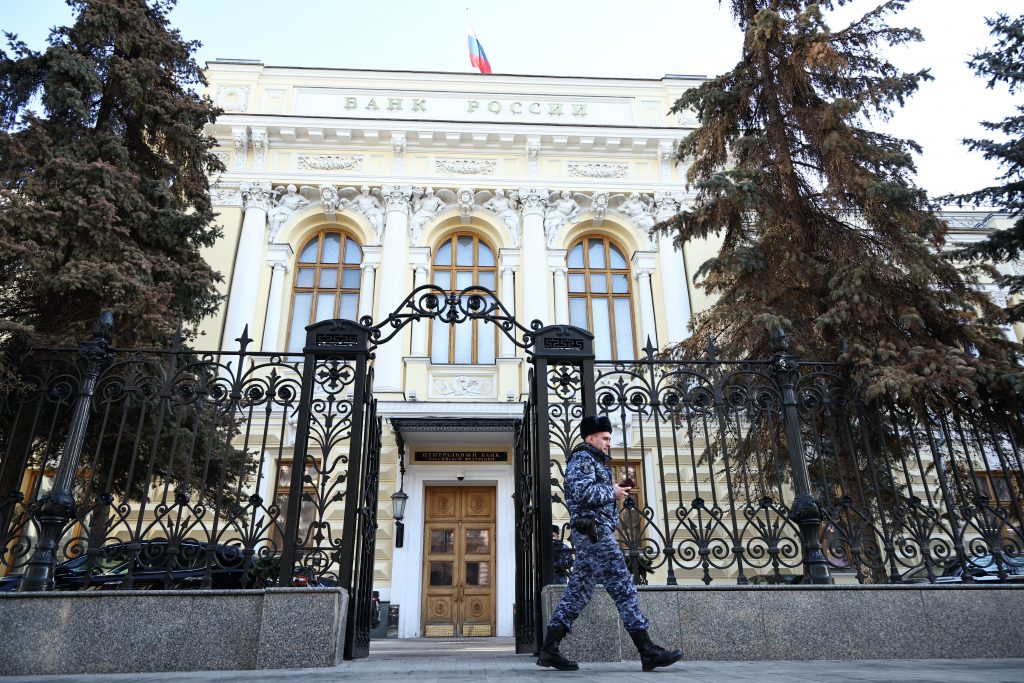Trading the Potential for a Russian Sovereign Debt Default
Risks in the global financial system appear to be rising as recent reports indicate Russia may soon default on its sovereign debt obligations.

Crippling sanctions levied by the West have likely helped reduce Russia’s appetite for war, but they may have also increased risks to the global financial system.
As soon as March 16, those risks may come to bear, as Russia is scheduled to pay the coupons on two dollar-denominated sovereign bonds. If the Russian government fails to service those debts—or tries to submit payment using rubles or yuan instead of U.S. dollars—the country would officially move into default.
That would be the first sovereign debt default for Russia since 1998.
Interestingly, Russia has plenty of cash to service its debts. The problem is that Russia can’t access a large chunk of its foreign currency reserves due to the aforementioned sanctions.
Since Russia first invaded Ukraine in 2014, the Russian government has been stockpiling reserves of foreign currency. From 2014 to 2022, Russia’s foreign currency reserves nearly doubled, rising from about $360 billion to nearly $700 billion.
Russian leaders were likely planning to use those reserves to help support the economy in the event of a situation like the one unfolding today. However, the United States, Europe and Japan threw a wrench in that plan when they froze a chunk of those reserves as a part of their punitive sanctions. Estimates suggest that about half of Russia’s foreign currency reserves held overseas are now frozen.
As a result, many international financial institutions have been left wondering how, or if, Russia will repay its external sovereign debts. The graphic below illustrates the upcoming maturities of Russian sovereign debt, including those debts coming due in 2022 and 2023.
The Russian debt situation has gotten so critical that Chairperson and Managing Director of the International Monetary Fund Kristalina Georgieva said on March 13 that a Russian sovereign debt default is “no longer an improbable event.”
Underscoring the critical nature of the situation, the credit rating agency Fitch downgraded Russian debt to a “C” rating not long after Western sanctions were levied against the country. Fitch noted at the time of that rating adjustment that a “sovereign default is imminent.”
These comments suggest that a near-term default is all but guaranteed, but the potential fallout from a Russian default isn’t easily understood.
Sovereign debt, i.e. government debt, is usually broken into two categories: domestic and external. The former refers to debt held by domestic holders (i.e. Russian institutions and citizens) while the latter refers to debt held by foreign entities.
In relative terms, Russia’s total external debt isn’t considered a large burden. Russia’s total sovereign debt is only estimated at about $40 billion. Adding in corporate debt, most estimates suggest that international banks are owed a total of $120 billion by Russian entities.
That amount is on par with Argentina’s last default in 2020, which did not end up catalyzing a global financial crisis. However, there’s no definitive playbook when it comes to sovereign defaults because no two are alike.
For example, if a critical global financial institution is caught holding a concentrated position of Russian debt, that institution’s solvency could come into question and potentially catalyze a broader crisis.
For now, Russia still has access to roughly 13% of its foreign currency reserves—the portion held in Chinese yuan.
The existence of that stockpile is why some market pundits think Russia will try to pay its dollar-denominated debt using Chinese currency on March 16. However, that would still technically trigger a default because the repayment currency stipulated in the loans is U.S. dollars.
It should be noted that if Russia does fail to submit payment on March 16, the country would likely be given a 30-day grace period before an actual default is triggered.
Considering the broader geopolitical landscape, that’s a key window of time in which Russia could theoretically attempt to negotiate a truce with Ukraine and ultimately avoid default altogether.
Regardless of the grace period, it seems likely that a Russian default would serve as a catalyst for further deprecation in the ruble. For this reason, investors and traders may want to watch the dollar/ruble exchange rate closely in the coming weeks.
Exchange rates are typically quoted using the format “ABC/DEF” and are interpreted to mean that the first currency listed is a single unit, while the exchange rate itself represents the amount of the second currency required to purchase a single unit of the first currency.
Prior to Russia’s expanded invasion of Ukraine, the dollar/ruble exchange rate was roughly 75. The exchange rate has since plummeted to about 120—meaning that today it takes 120 Russian rubles to purchase a single U.S. dollar.
To learn more about the impact of the Russo-Ukrainian war on the global financial markets, readers are encouraged to review this new installment of Truth or Skepticism featuring tastytrade co-founder Tom Sosnoff and longtime market pundit Dylan Ratigan.
For more information about trading foreign currencies, this episode of Market Mindset is also recommended. To follow everything moving the markets, readers can also tune into TASTYTRADE LIVE weekdays from 7 a.m. to 4 p.m. Central Time at their convenience.
Get Luckbox! Subscribe to receive 10-issues of Luckbox in print! See SUBSCRIBE or UPGRADE TO PRINT (upper right) for more info or visit getluckbox.com.
Sage Anderson is a pseudonym. He’s an experienced trader of equity derivatives and has managed volatility-based portfolios as a former prop trading firm employee. He’s not an employee of Luckbox, tastytrade or any affiliated companies. Readers can direct questions about this blog or other trading-related subjects, to support@luckboxmagazine.com.



















